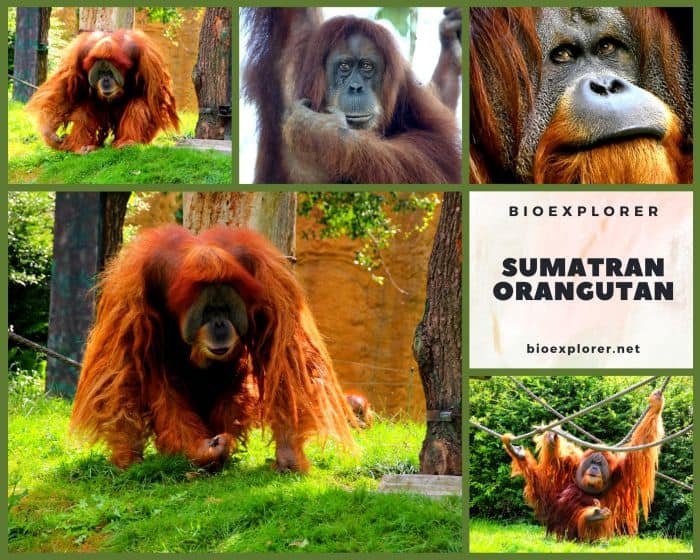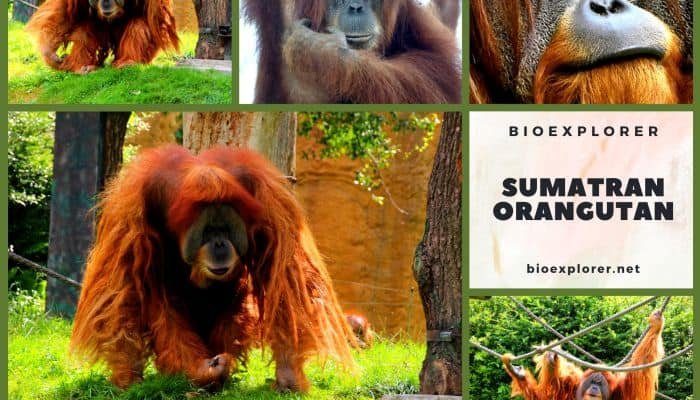
In this article, we’ll explore ten animals that, in one way or another, remind us of the Sumatran orangutan. You’ll discover how they compare in terms of appearance, habitat, and behavior. Each of these animals has its quirks and charms, so let’s dig in and see what makes them special—and how you can tell them apart.
1. Bornean Orangutan
When people think of orangutans, they often picture the Sumatran variety. However, the Bornean orangutan is another close relative. These two species share many traits but differ in notable ways. Bornean orangutans tend to have stockier bodies and darker fur compared to their Sumatran cousins. They also have broader faces, which can make them seem a bit more robust.
You might be wondering why both species exist. They evolved in different habitats: the Sumatran orangutan thrives in the lush forests of Sumatra, while the Bornean orangutan is native to Borneo’s tropical rainforests. Both species are critically endangered, mostly due to deforestation and habitat loss, making it essential for us to understand and protect them.
Key Differences:
- Body shape: Bornean orangutans are stockier.
- Fur color: Bornean orangutans have darker fur.
- Facial structure: Bornean orangutans have broader faces.
2. Gibbons
Gibbons are another primate type that shares some features with orangutans. Known for their long arms and agile swinging through trees, gibbons are often seen as the “acrobats” of the jungle. They have a lighter build than orangutans, and their fur varies in color from black to a creamy white, depending on the species.
One fascinating aspect of gibbons is their social behavior. They typically live in small family groups and use loud vocalizations to communicate. You might hear their calls echoing through the forest, which sounds like a mix of singing and howling. This social structure is quite different from orangutans, who are more solitary.
Key Differences:
- Body type: Gibbons are lighter and more agile.
- Social structure: Gibbons are more social than orangutans.
- Vocalization: Gibbons have distinct calls, while orangutans are more quiet.
3. Chimpanzees
Chimpanzees are perhaps one of our closest relatives in the animal kingdom, sharing about 98% of our DNA. They have a more muscular body compared to the slender build of the orangutan. Chimpanzee fur is usually black or dark brown, and they often have expressive faces that reflect a wide range of emotions.
Interestingly, chimpanzees live in larger social groups called troops. Unlike the mostly solitary orangutan, chimpanzees are quite social and often engage in cooperative behaviors. They’re known for using tools, making them one of the smartest primates besides humans.
Key Differences:
- Physical build: Chimpanzees are more muscular and compact.
- Fur color: Generally darker than orangutans.
- Social behavior: Chimpanzees live in troops, while orangutans are solitary.
4. Bonobos
Bonobos are often mistaken for chimpanzees, but they have distinct characteristics. They are slightly smaller and have a more slender build. Bonobos also have darker faces with a pinkish hue around their mouth, which gives them a different appearance compared to orangutans.
One of the most intriguing aspects of bonobos is their matriarchal social structure. The females often hold more power, which leads to more peaceful interactions among bonobos compared to other primate species. This behavior contrasts with orangutans, who are typically solitary and don’t have a strict social hierarchy.
Key Differences:
- Size: Bonobos are generally smaller than chimpanzees.
- Facial features: Bonobos have darker faces with pinkish mouths.
- Social system: Bonobos are matriarchal, unlike orangutans.
5. Mandrills
Mandrills are a striking species thanks to their colorful faces and bold markings. These primates are much larger than orangutans and have a more robust body shape. While they don’t share many physical similarities, their social behaviors are fascinating. Mandrills live in large groups and are known for their complex social interactions.
You might be surprised to learn that mandrills can be quite vocal and use a variety of sounds for communication. Their bright coloration serves as a way to communicate their mood and health to others in their troop, which is quite different from the more reserved nature of orangutans.
Key Differences:
- Size: Mandrills are larger and more robust.
- Coloration: Mandrills have bright colors on their faces.
- Social behavior: Mandrills live in large troops, while orangutans are solitary.
6. Capuchin Monkeys
Capuchin monkeys might not be large like the Sumatran orangutan, but they share some interesting similarities. They are known for their intelligence and agility. With their small, agile bodies, they can also swing through trees, albeit not as gracefully as their larger cousins.
Capuchins often work together to find food and communicate effectively with one another. Their playful nature can be charming and reminds us of the more playful side of orangutan behavior, especially when they’re young! However, their smaller size and different habitats set them apart.
Key Differences:
- Size: Capuchins are much smaller and lighter.
- Social behavior: Capuchins live in larger groups and are very social.
- Communication: Capuchins are very vocal and engage in playful antics.
7. Tarsiers
Tarsiers are tiny primates known for their large eyes and ability to rotate their heads 180 degrees—kind of like a living owl! Although they’re quite different from orangutans, there’s something intriguing about how they also rely on trees for their habitat. Tarsiers have a distinctive look that sets them apart, with their tiny bodies and incredible leaping ability.
These creatures are nocturnal, spending their nights hunting for insects and other small prey. Their unique adaptation to nighttime living contrasts with the more arboreal lifestyle of orangutans. Despite their size, tarsiers are relentless hunters, showcasing a different aspect of primate life.
Key Differences:
- Size: Tarsiers are much smaller than orangutans.
- Activity: Tarsiers are nocturnal, while orangutans are diurnal.
- Habitat: Tarsiers prefer dense forests, while orangutans live in tropical rainforests.
8. Sifakas
Sifakas are unique lemurs found in Madagascar. With their long legs and arms, they are known for their distinctive sideways hopping—making them one of the more entertaining primates to watch! While they don’t look much like orangutans, their tree-dwelling habits and social structures give them some resemblance.
Sifakas are social creatures and live in family groups, often seen grooming one another. This behavior strengthens their bonds, similar to how orangutans interact during brief encounters. However, sifakas are primarily herbivorous, while orangutans have a more varied diet that includes fruits and insects.
Key Differences:
- Physical features: Sifakas have a different body structure and fur color.
- Movement: Sifakas hop sideways, while orangutans swing through trees.
- Diet: Sifakas are herbivorous, while orangutans have a varied diet.
9. Spider Monkeys
Spider monkeys are known for their long limbs and prehensile tails, which set them apart from many other primate species. Just like orangutans, they thrive in treetops, using their tails to grasp branches while swinging gracefully. However, their fur is typically darker, and they possess a more elongated body.
These monkeys are social animals that often live in groups called troops, and their playful nature leads to plenty of social interactions. Their vocalizations can also be quite loud, contrasting the quieter lifestyle of orangutans, who prefer solitude.
Key Differences:
- Body structure: Spider monkeys have longer limbs and prehensile tails.
- Social behavior: They live in groups, while orangutans are more solitary.
- Fur color: Spider monkeys tend to have darker fur.
10. Slow Loris
The slow loris might seem like an odd animal to include, but hear me out. These nocturnal primates are known for their slow, deliberate movements—almost like they’re in slow motion! While they don’t look much like orangutans, their tree-dwelling habits and primate classification make them an interesting comparison.
Slow lorises are unique because of their toxic bite, which is quite rare among primates. They can be found in Southeast Asia and are primarily solitary, echoing the solitary nature of orangutans. However, their small stature and distinct behaviors make them quite different when compared side-by-side.
Key Differences:
- Size and movement: Slow lorises are much smaller and move slowly.
- Behavior: They have a toxic bite, unlike orangutans.
- Habitat: Found in different regions of Southeast Asia.
In conclusion, while the Sumatran orangutan holds a special place in the animal kingdom, it’s fascinating to look at other primates that share some of their traits. Each of these animals has its own unique charm and characteristics that set them apart. By understanding the differences and similarities, we can appreciate the diversity of life around us. Whether we’re talking about their habitat, behavior, or physical features, these comparisons help deepen our understanding of the animal world. So, the next time you come across these remarkable creatures, you’ll know just how special each one is!

